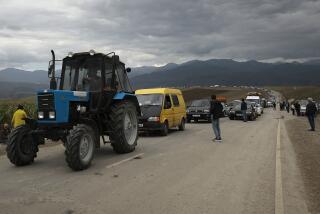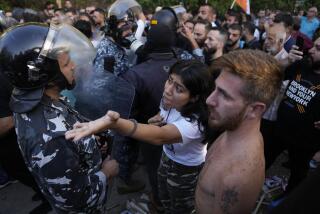A Shock to the Soviet Foundation : In Armenian Rubble, Moscow’s Ethnic Problems Grow
- Share via
Nations, like human beings, often reveal their true selves in catastrophe. So, more than a month after the Armenian earthquake, we may ask: What do we know about the Soviet Union that we didn’t see so clearly before?
It has become much clearer that the Union of Soviet Socialist Republics is hardly “a more perfect union” in any American sense, but an imperfect confederation of nations, held together with difficulty by force, central economic planning and political maneuvering.
What could more dramatically illustrate divisive nationalism within the Soviet Union than Mikhail S. Gorbachev, standing in the rubble, arguing with hot-headed nationalists about Nagorno-Karabakh, the territory claimed by both Christian Armenia and Muslim Azerbaijan?
One might have expected that in a disaster, the living would put aside political differences to dig out the perishing. But no. Gorbachev encountered fierce nationalistic outbursts. These flare-ups were far more than minor excesses of the new openness of glasnost.
Last December, the world saw more clearly than before that Armenians are deeply emotional and possibly paranoid. Like the Jews, they fear extinction. Armenia once spread all over Asia Minor and produced one of the first organized churches outside Rome. Over the last 1,000 years Armenia has lost the vast majority of its territory. The Turkish massacres between 1890 and 1920 substantially reduced the population. No wonder the Armenians feel threatened by their Muslim neighbors, who are reproducing at four times the Armenians’ rate, or that they took offense when Gorbachev offered to resettle Armenian orphans in Russian parts of the Soviet Union.
Nor is Armenia’s concern about its identity and survival unique for the Soviet Union. Many other of the 15 constituent republics and 100 ethnic groups are straining under Moscow’s rule and penchant for Russification. Estonia, Latvia and Lithuania, with separate languages and cultures, would like to recover the independence they enjoyed between the two world wars. The Ukraine remembers its unsuccessful struggle for autonomy in the year of the Russian Revolution. Soviet Georgia might well walk away from the union if it could.
Gorbachev’s No. 1 problem may be the flagging Soviet economy, but the trembling of an ethnic earthquake is surely No. 2.
For all his finesse as a statesman and media star in the West, Gorbachev can be politically clumsy at home. To appear in Yerevan dressed in his New York overcoat and fedora hat, to insist on standing First Lady Raisa before the TV cameras still dressed in Manhattan finery, was insensitive. No wonder many Armenians felt that he might be a powerful Moscow bureaucrat but hardly a close friend.
In Yerevan, Gorbachev displayed emotions that Western observers rarely see--anger and impatience high among them. Indeed, he seemed to confirm his own harsh judgment that Russians have still a great deal to learn about respect for others’ points of view; about the search for compromise. Shocked by the die-hard nationalism he encountered, Gorbachev responded in kind. He called those who would fan politics amid disaster “demagogues, parasites, political opportunists.”
The vehemence of his language was a political mistake. He raised doubts that he himself could be objective and capable of reasonable dialogue. Politically, he disqualified himself as an honest broker and he will have to find someone else to help mediate the bitter dispute between Armenia and Azerbaijan. Could it really be academician Andrei Sakharov?
The Armenian earthquake showed off to the Western world the difference between Soviet policy and implementation. This gap has traditionally been the weakest link in Soviet administration. I remember in the mid-1980s listening to experts at the Moscow Institute of Earth Physics vaunt their abilities at earthquake prediction and their respect for stringent building codes. Yet in Armenia last month, many of the more modern buildings collapsed, no doubt because of irresponsible but time-honored circumvention of regulations.
Moscow’s decision to allow enormous amounts of foreign aid to flow into Armenia exposed a number of flaws that Soviet officials would have preferred to cover up: Relief teams that would not deliver aid because no surviving bureaucrat could be found to sign for them; lack of home-trained sniffer dogs and rescue squads; premature hankerings to call off the search for survivors and send the foreign rescue teams away.
These examples of mismanagement should bring reassurance, however, in one area of Soviet-American relations. Can anyone really believe anymore that the Soviet civil defense program, so feared by the American far right as a strategic gambit, is a paragon of efficiency? Is it plausible to think that Moscow could hope that its civil defense program would help it survive a nuclear war with the United States?
More to Read
Sign up for Essential California
The most important California stories and recommendations in your inbox every morning.
You may occasionally receive promotional content from the Los Angeles Times.










